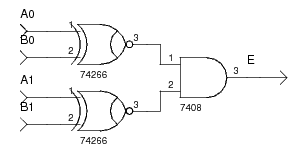Comparator
A comparator is used to compare two bit sequences bit by bit.
A basic comparator will output 1 if both bit sequences are the same.
A magnitude comparator will interpret the bit sequences as numbers, say A and B,
and may generate different outputs depending on whether A = B, A < B, or A > B.
If we take a 2-bit basic comparator with inputs A (with bits A1 A0) and
B (with bits B1 B0) and define
the outputs E to be 1 if A = B, then we have the following truth table
A1 |
A0 |
B1 |
B0 |
E |
|---|---|---|---|---|
0 | 0 | 0 | 0 | 1 |
0 | 0 | 0 | 1 | 0 |
0 | 0 | 1 | 0 | 0 |
0 | 0 | 1 | 1 | 0 |
0 | 1 | 0 | 0 | 0 |
0 | 1 | 0 | 1 | 1 |
0 | 1 | 1 | 0 | 0 |
0 | 1 | 1 | 1 | 0 |
1 | 0 | 0 | 0 | 0 |
1 | 0 | 0 | 1 | 0 |
1 | 0 | 1 | 0 | 1 |
1 | 0 | 1 | 1 | 0 |
1 | 1 | 0 | 0 | 0 |
1 | 1 | 0 | 1 | 0 |
1 | 1 | 1 | 0 | 0 |
1 | 1 | 1 | 1 | 1 |
From this we can generate the Boolean equation
E = ((A0 and B0) or (not(A0) and not(B0))) and ((A1 and B1) or (not(A1) and not(B1))).
If we use the exclusive-nor operator (xnor), then this can be written much more simply as:
E = (A1 xnor B1) and (A0 xnor B0).
This can be generalised for an N-bit basic comparator as follows:
E = (AN xnor BN) and ... and (A1 xnor B1) and (A0 xnor B0).
Schematic
We can realise the basic comparator with logic gates as follows:

Verilog
Below is the Verilog code for a structural model of a 2-bit basic comparator:
module two_bit_basic_comparator(E, A, B);
output E;
input [1:0] A;
input [1:0] B;
wire e0;
wire e1;
xnor(e1, A[1], B[1]);
xnor(e0, A[0], B[0]);
and(E, e1, e0);
endmodule
References
Kleitz, W. Digital Microprocessor Fundamentals. 3rd Edition. Prentice Hall, 2000.